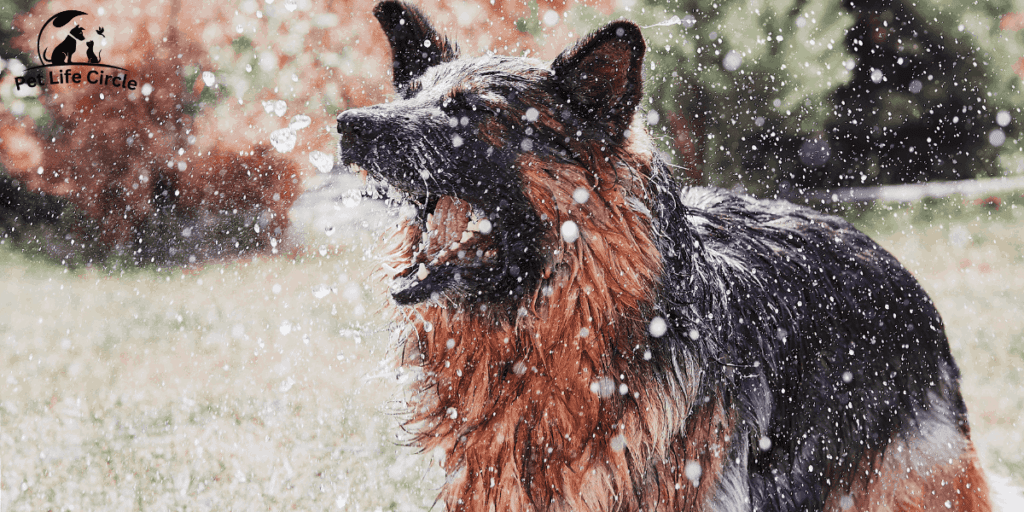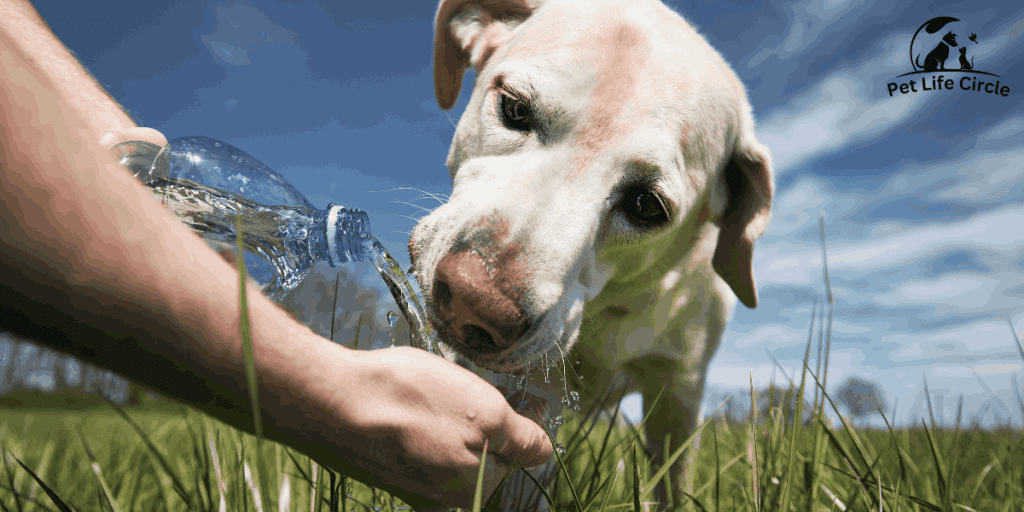How to Hydrate a Dog Fast & Keep Them Healthy and Happy!
Table of Contents
ToggleEnsuring your dog stays well-hydrated is critical to maintaining their health and well-being. Dogs, like humans, need fluids to help their body function correctly, especially after activities like running or playing. Without enough hydration, your dog can suffer from dehydration, leading to serious health problems and affecting their organs and digestion. It’s important to understand that electrolytes are essential when replenishing lost fluids, as they help restore balance and prevent dehydration from affecting your dog’s body systems.
If you notice your dog becoming dehydrated, it’s crucial to act fast. Offering water or an electrolyte-rich fluid can help them recover quickly and stay well-hydrated. You can prevent dehydration and promote proper hydration by consistently providing fluids during playtime, after walks, or when the weather is hot. Keeping an eye on their body for signs of dehydration and offering hydration solutions can ensure their health and overall well-being remain in top shape.
The Importance of Proper Hydration for Dogs
Role of Hydration in Canine Health:
Hydration is essential for your dog’s overall health and well-being. It helps:
- Regulate body temperature
- Support vital organs
- Aid digestion for proper nutrient absorption and waste elimination
Risks of Dehydration
Without enough fluids, dehydration can cause serious complications, including:
- Organ failure
- Severe weakness
- Death in extreme cases
Ensuring your dog drinks enough fluids is crucial to preventing serious injury and maintaining energy levels for daily activities and playtime.
The Role of Electrolytes:
Like all mammals, dogs need a balanced electrolyte system to function correctly. Key minerals such as:
- Potassium
- Sodium
- Chloride
These electrolytes help maintain hydration balance and support overall bodily functions.
Recognizing Dehydration Symptoms:
Watch for early signs of dehydration, such as:
- Dry nose
- Lethargy
- Lack of appetite
Responding to Dehydration:
If your dog shows these signs, take action immediately by:
- Providing supplements or fluids to relieve mild dehydration
- Seeking veterinary care for severe cases
Severe dehydration can lead to:
- Kidney problems
- Loss of consciousness
Timely treatment is critical to avoid dangerous health complications.
Ensuring Long-Term Hydration:
By prioritizing hydration, you can:
- Prevent long-term health issues
- Maintain a healthy coat
- Support a substantial overall health system
Act early to keep your dog feeling their best and enjoying a healthy life!

Recognizing Dehydration in Dogs
Early Signs of Dehydration:
If you’re concerned that your dog might be dehydrated, look for these clear signs:
- Dry or sticky nose
- Gums that aren’t moist and pink
Skin Elasticity Test:
You can check their skin elasticity by gently pinching a fold of skin on their neck. If it takes longer than usual to return to normal, it’s a red flag for dehydration.
Behavioral and Physical Symptoms:
Other dehydration symptoms include:
- Lethargy or weakness
- Lack of interest in activities
- Excessive panting
- Sunken or dry eyes
Severe Dehydration Warning Signs:
If your dog is experiencing vomiting, diarrhea, or loss of appetite, it could indicate severe dehydration. Immediate veterinary attention is necessary to prevent complications such as shock.
Importance of Prompt Action:
Be alert to these symptoms, as quick action is crucial to preventing serious health issues caused by dehydration.
How Much Water Does Your Dog Need to Stay Hydrated?
Water Requirements Based on Weight and Factors:
The amount of water your dog needs depends on several factors, including weight, activity level, breed, and life stage. Generally, dogs require about one ounce of water per pound of body weight.
- Example: A 20-pound dog needs approximately 20 ounces of water daily.
- Dogs with thick coats, larger breeds, or those living in hot climates require more water to stay hydrated.
- Puppies, nursing, and pregnant dogs need additional fluids for growth, lactation, and physiological changes.
Signs of Dehydration:
Monitor your dog’s hydration levels carefully. If you notice any signs of dehydration or severe dehydration, take action immediately to prevent health complications.
Importance of Electrolytes:
Apart from water, electrolytes such as sodium, potassium, and chloride are essential for:
- Maintaining pH balance
- Regulating muscle function
- Supporting nerve function
Additional Hydration Needs for Active Dogs:
If your dog is highly active, spends time outdoors, or engages in vigorous exercise, they lose more fluids through panting and physical exertion, requiring more water intake.
Tips for Hydrating Picky Drinkers:
If your dog is a picky drinker, try:
- Offering bone broth
- Giving ice cubes
These can make hydration more appealing.
Monitoring Water Intake in Extreme Weather:
Always be mindful of your dog’s hydration needs, especially in extreme weather conditions. Monitor their water intake regularly to prevent fluid loss and ensure their well-being.

Dehydration in Dogs: Causes, Risks, and Prevention
Causes of Dehydration in Dogs:
Dehydration in dogs can occur due to several reasons, including:
- Vomiting and diarrhea lead to fluid loss.
- Heatstroke or fever, which increases water loss.
- Excessive panting, especially in hot weather or during vigorous exercise.
- Sweating through their paws and high activity levels increase water requirements.
- Medical conditions such as kidney failure or certain antibiotics can cause increased fluid loss.
Dogs at Higher Risk of Dehydration:
Some dogs are more susceptible to dehydration, including:
- Dogs with kidney disease.
- Older dogs.
- Nursing or pregnant dogs.
- Small or toy breeds as they are more vulnerable to dehydration.
Preventing Dehydration:
To keep your dog adequately hydrated:
- Always provide fresh water.
- Consider offering electrolyte-infused water to replenish lost sodium, potassium, and chloride.
Risks of Severe Dehydration:
Without adequate hydration, dehydration can lead to:
- Organ failure.
- Fatal consequences if left untreated.
Monitoring and Seeking Veterinary Help:
Watch out for signs of dehydration, such as:
- Excessive thirst.
- Reduced or lack of water intake.
If symptoms persist or worsen, seek immediate veterinary assistance.
How to Rehydrate a Dehydrated Dog
Act Quickly and Consult a Vet:
If your dog is dehydrated, immediate action is crucial.
- Consult your vet for a proper diagnosis and treatment plan.
- In cases of severe dehydration, your vet may administer intravenous (IV) or subcutaneous fluids to replace lost fluids.
- Dogs at higher risk (older, small breeds, pregnant, or nursing dogs) need extra monitoring and care.
- Offer small amounts of water frequently to help rehydration without overwhelming their system.
Offer Fresh, Clean Water at All Times:
Ensuring your dog has access to fresh and clean water is key to preventing dehydration.
- Use stainless steel or ceramic bowls to reduce bacteria buildup.
- Give your dog ice cubes or crushed ice on hot days to help maintain their electrolyte balance.
- Regularly replace the water to keep it fresh and free of contaminants.
Provide Access to Multiple Water Sources:
Place water bowls in multiple locations around your home and yard to make hydration convenient.
- Keep water bowls in easily accessible spots like the kitchen, living room, and backyard.
- Use pet water fountains to encourage drinking.
- Preventing your dog from drinking contaminated water sources (such as toilets or puddles) could lead to illness.
Choose the Right Water Bowl or Fountain:
Selecting an appropriate water bowl or dispenser can help your dog drink more comfortably.
- Large breeds may need big water bowls or self-filling dispensers.
- Small dogs might prefer smaller bowls with narrower openings.
- Add a splash of lemon juice or fruit slices to their water to make it more appealing and refreshing.
- Consider placing multiple water bowls around the house for easy access.
Incorporate Interactive Toys and Frozen Treats:
Make hydration fun with interactive toys and frozen treats.
- Try water-dispensing toys to encourage drinking.
- Offer frozen dog-friendly broth or frozen watermelon as a refreshing treat.
- Ice cubes can be a playful and hydrating snack.
- These treats are especially beneficial for puppies, seniors, and toy breeds needing extra hydration.
Monitor and Adjust Water Intake:
Regularly check your dog’s water consumption to ensure they’re drinking enough.
- Look for dehydration symptoms such as dry gums, lethargy, or sunken eyes.
- Dogs with vomiting or diarrhea need extra fluids to compensate for losses.
- If your dog shows persistent dehydration, consult your veterinarian for proper hydration guidance.
Schedule Water Breaks During Exercise:
When engaging in physical activities, make sure your dog stays hydrated.
- Provide frequent water breaks during walks, runs, or playtime.
- Water helps replenish lost electrolytes and keeps them energized.
- Remember, dogs need at least one ounce of water per pound of body weight daily, but they may require more with exercise or hot weather.

Is Your Dog Drinking Enough Water? Essential Hydration Tips for a Healthy Pup
Importance of Hydration for Dogs:
Keeping your dog hydrated is essential for their overall health and well-being. Proper hydration helps with:
- Digestion
- Energy levels
- Maintaining a glossy coat
Dogs More Prone to Dehydration:
Certain dogs are more vulnerable to dehydration, including:
- Puppies
- Senior dogs
- Toy dog breeds
If dehydration is not addressed, it can lead to serious health complications such as kidney failure or even loss of consciousness.
Signs of Dehydration:
Watch for early symptoms of dehydration, including:
- Lethargy
- Dry gums
Encouraging Hydration:
If your dog is reluctant to drink water, try these hydration-boosting tips:
- Add low-sodium broth to their water.
- Mix in fruits and vegetables to make it more appealing.
- Offer homemade frozen broth water cubes as treats.
Dealing with Extreme Dehydration:
In cases of severe dehydration caused by:
- Vomiting
- Diarrhea
- Heatstroke
You can provide hydration solutions like DoggyRade or electrolyte replacement fluids to help restore lost fluids.
Monitoring Hydration Levels:
Constantly monitor your dog’s water intake to prevent severe fluid loss and maintain their health.
Final Thoughts on how to hydrate a dog fast
Ensuring your dog stays adequately hydrated is fundamental to their overall health and well-being. Water plays a crucial role in your dog’s daily life, from regulating body temperature and aiding digestion to maintaining energy levels and supporting organ function. Recognizing the early signs of dehydration—such as lethargy, dry gums, and excessive panting—can help you take quick action to prevent serious complications. Providing fresh, clean water at all times, incorporating hydration-boosting treats, and monitoring their intake are essential to keep them healthy and active.
Immediate intervention is necessary if your dog’s dehydration worsens due to illness, heatstroke, or excessive activity. Hydration solutions such as electrolyte-infused water, bone broth, or veterinary care can significantly improve its recovery. By being proactive and attentive to your furry companion’s hydration needs, you can ensure that your furry companion remains happy, energetic, and well-hydrated for years to come. Always prioritize your dog’s hydration, especially in hot weather or high-activity situations, to prevent health risks and keep your dog thriving.



